Properties
| Storage Buffer | PBS pH7.4, 50% glycerol, 0.09% sodium azide *Storage buffer may change when conjugated |
| Storage Temperature | -20ºC, Conjugated antibodies should be stored according to the product label |
| Shipping Temperature | Blue Ice or 4ºC |
| Purification | Protein G Purified |
| Clonality | Monoclonal |
| Clone Number | 22B1 |
| Isotype | IgG1 |
| Specificity | Detects phosphorylated CaMKII from rat tissues. This antibody is specific for α and β subunits of CaMKII only when they are phosphorylated at Thr-286/287 (in β). |
| Cite This Product | StressMarq Biosciences Cat# SMC-125, RRID: AB_2067924 |
| Certificate of Analysis | 1 µg/ml was sufficient for detection of 0.2 µg CamKII by colorimetric immunoblot analysis using Goat Anti-Mouse IgG:HRP as the secondary. |
Biological Description
| Alternative Names | CSAID Binding protein 1 Antibody, CSBP1 Antibody, CSBP2 Antibody, EXIP Antibody, MAP kinase MXI2 Antibody, MAPkinase p38alpha Antibody, MAPK14 Antibody, p38 ALPHA Antibody, p38 MAP kinase Antibody, p38 mitogen activated protein kinase Antibody, RK Antibody, SAPK 2A Antibody, Stress activated protein kinase 2A Antibody |
| Research Areas | Cell Signaling, Phosphorylation, Post-translational Modifications |
| Cellular Localization | Cell Junction, Cytoplasm, Mitochondrion, Nucleus, Presynaptic Cell Membrane, Synapse |
| Accession Number | NP_037052.1 |
| Gene ID | 25400 |
| Swiss Prot | P11275 |
| Scientific Background | CaMKII is an important member of the calcium/calmodulin-activated protein kinase family, functioning in neural synaptic stimulation and T-cell receptor signaling (1, 2). CaMKII is expressed in many different tissues but is specifically found in the neurons of the forebrain and its mRNA is found within the dendrites and the soma of the neuron. The CaMKII that is found in the neurons consist of two subunits of 52 (termed alpha genes) and 60 kDa (beta genes). CaMKII has catalytic and regulatory domains, as well as an ATP-binding domain, and a consensus phosphorylation site (3-7). The binding of Ca2+/calmodulin to its regulatory domain releases its auto inhibitory effect and activates the kinase (8). This kinase activation results in autophosphorylation at threonine 286 (8). The threonine phosphorylation state of CaMKII can be regulated through PP1/PKA. Whereas PP1 (protein phosphatase 1) dephosphorylates phospho-CaMKII at Thr286, PKA (protein kinase A) prevents this dephosphorylation (9). Autophosphorylation also enables CaMKII to attain an enhanced affinity for NMDA receptors in postsynaptic densities (10-12). |
| References |
1. Hughes K. et al. (2001) J. Biol. Chem. 276: 36008–36013. 2. Barria A. et al. (1997) Science 276: 2042–2045. 3. Bennet M.K. and Kennedy M.B. (1987) Proc. Natl. Acad. Sci. U.S.A. 84: 1794-1798. 4. Broke L., Srinivasan M. and Schulman H. (1995) J. Neurosci. 15: 6797-6808. 5. Nghiem P., Saati S. M., Martens C. L., Gardner P. and Schulman H. (1993) J. Biol. Chem. 268: 5471-5479. 6. Edman C.F. and Schulman H. (1994) Biochem. Biophys. Acta 1221: 90-102. 7. Tombes R.M. and Krystal G.W., (1997) Biochem. Biophys. Acta 13555: 281-292. 8. Means A.R. (2000) Mol. Endocrinol. 14: 4–12. 9. Makhinson M. et al. (1999) J. Neurosci. 19: 2500–2510. 10. Strack S. and Colbran R.J. (1998) J. Biol. Chem. 273: 20689-20692. 11. Leonard S.A., Lim I.A., Hemsworth D.E., Horne M.C. and Hell J.W. (1999) Proc. Natl. Acad. Sci. U.S.A. 96: 3239-3244. 12. Shen K. and Meyer Y. (1999) Science 284: 162-167. |
Product Images
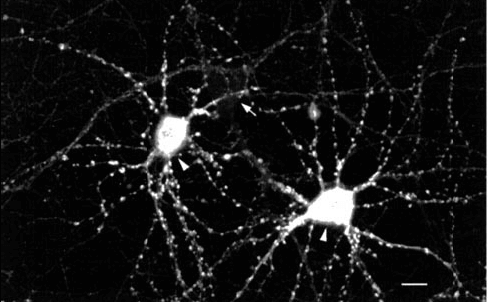
Immunocytochemistry/Immunofluorescence analysis using Mouse Anti-CaMKII Monoclonal Antibody, Clone 22B1 (SMC-125). Tissue: dissociated hippocampal neurons. Species: Rat. Fixation: Cold 4% paraformaldehyde/0.2% glutaraldehyde in 0.1M sodium phosphate buffer. Primary Antibody: Mouse Anti-CaMKII Monoclonal Antibody (SMC-125) at 1:1000 for 12 hours at 4°C. Secondary Antibody: FITC Goat Anti-Mouse IgG (green) at 1:50 for 30 minutes at RT. Magnification: 10X. Courtesy of: Mary Kennedy, Caltech.
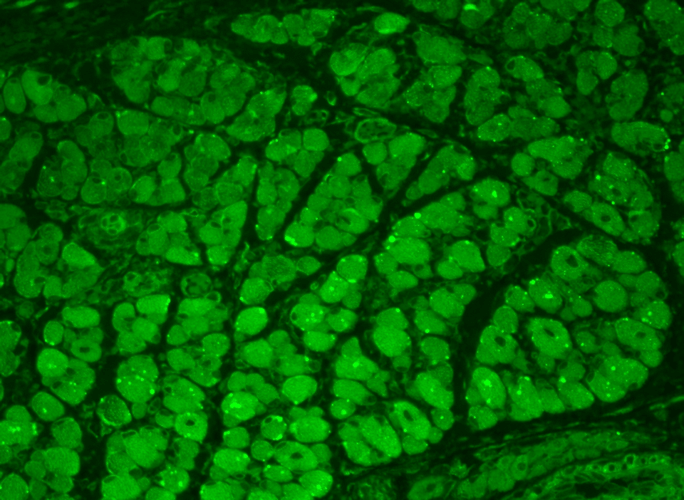
Immunohistochemistry analysis using Mouse Anti-CaMKII Monoclonal Antibody, Clone 22B1 (SMC-125). Tissue: backskin. Species: Mouse. Fixation: Bouin’s Fixative and paraffin-embedded. Primary Antibody: Mouse Anti-CaMKII Monoclonal Antibody (SMC-125) at 1:100 for 1 hour at RT. Secondary Antibody: FITC Goat Anti-Mouse (green) at 1:50 for 1 hour at RT. Localization: Muscle, hair follicle, epidermis. Backskin obtained from transgenic mice.
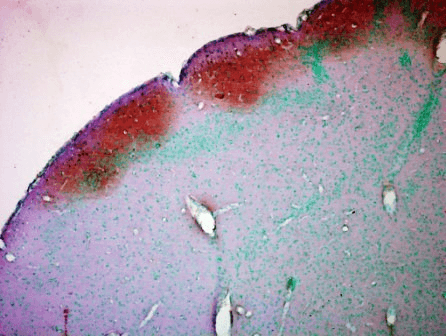
Immunohistochemistry analysis using Mouse Anti-CaMKII Monoclonal Antibody, Clone 22B1 (SMC-125). Tissue: colon carcinoma. Species: Human. Fixation: Formalin. Primary Antibody: Mouse Anti-CaMKII Monoclonal Antibody (SMC-125) at 1:5000 for 12 hours at 4°C. Secondary Antibody: Biotin Goat Anti-Mouse at 1:2000 for 1 hour at RT. Counterstain: Mayer Hematoxylin (purple/blue) nuclear stain at 200 µl for 2 minutes at RT. Magnification: 40x.
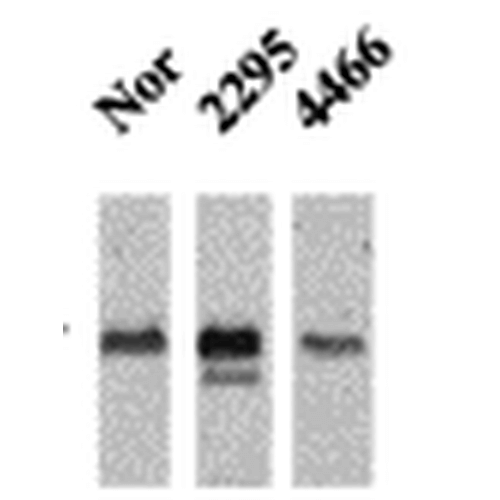
Western Blot analysis of Mouse Ventricle lysates showing detection of CaMKII protein using Mouse Anti-CaMKII Monoclonal Antibody, Clone 22B1 (SMC-125). Primary Antibody: Mouse Anti-CaMKII Monoclonal Antibody (SMC-125) at 1:1000. Analysis of CaMKII and NFAT phosphorylation in ventricles of 14 day old mice over-expressing CaMK.

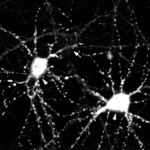
![Mouse Anti-CaMKII Antibody [22B1] used in Immunohistochemistry (IHC) on Mouse backskin (SMC-125)](https://www.stressmarq.com/wp-content/uploads/SMC-125_CaMKII_Antibody_22B1_IHC_Mouse_backskin_8-100x100.png)
![Mouse Anti-CaMKII Antibody [22B1] used in Immunohistochemistry (IHC) on Human colon carcinoma (SMC-125)](https://www.stressmarq.com/wp-content/uploads/SMC-125_CaMKII_Antibody_22B1_IHC_Human_colon-carcinoma_40x_1-100x100.png)
![Mouse Anti-CaMKII Antibody [22B1] used in Western Blot (WB) on Mouse Ventricle lysates (SMC-125)](https://www.stressmarq.com/wp-content/uploads/SMC-125_CaMKII_Antibody_22B1_WB_Mouse_Ventricle-lysates_1-100x100.png)




















StressMarq Biosciences :
Based on validation through cited publications.